Bridges. We cross them routinely, often barely noticing they are there. Yet without them, we would have to take long and circuitous detours or make dangerous crossings. So I like to pause sometimes and reflect on the bridge builders, whether physical or metaphorical, and nod my thanks to them for making my journey easier and safer.
Many kinds of bridges
In my working life, I would, at least once a year, board a plane and fly across the globe to talk face-to-face with my counterparts in other countries. And each time I was asked, why not just do a video conference with them? Why do I have to meet them face-to-face? My answer had variations on a theme. And that theme was about building firm relationships between the people of that country and our own. It was only partly about the exchange of formal information, but it was far more about building trust. And that trust was built by sharing a meal, having a joke, by spending informal time with them. And in that process, walking a little in their shoes, and they in mine.
In many ways, the aircraft formed a bridge between our cultures, just as surely as if I had walked across a physical bridge from one side of a river to the other, as pilgrims have done on the Camino for a thousand years. As you enter Santiago de Compostela, you will see inscribed in brass letters the phrase “Europe was built on the pilgrim road to Santiago.” Similarly, I have written elsewhere about the painter Van Gogh and the way he built his own bridge to the print-makers of Japan – notably Hiroshige. The influence of those Japanese prints transformed how painters like Van Gogh saw the world, by literally gaining a new perspective.
Van Gogh’s bridges
I built my own bridge to Van Gogh’s work by seeing the bridges that inspired him in Arles (also a starting point for one of the Camino routes) – the railway bridge near the Yellow House, and the Langlois Bridge across the canal, as well as the Edo Bridge in Tokyo, through seeing the replica in the Edo-Tokyo Museum which inspired Hiroshige, and then Van Gogh.
![pont de Van Gogh, Arles France. [photo Jerry Everard]](https://thefogwatch.com/wp-content/uploads/2015/08/MG_2649.jpg)
Why are bridges special?
Bridges are special places, whether a few flat stones used to cross a stream, perhaps placed in Neolithic times, or stone spans built by Roman engineers 2000 years ago, or by later medieval builders, and modern freeway spans and great suspension bridges. They are special because they help us cross over. They help us cross safely from here to there over an abyss or a raging torrent, across an absence of firm ground.
Bridges are a place between places, and once you step onto a bridge, you too, are, for that moment, in between. Once you step onto that bridge, you have left your safe homeland, and you are already on that journey to the next place, to another culture, or another town or village. Bridges enable you to do this despite the storm or the deep water, or the treacherous ford.
Where walls enclose “us” from “them”, bridges make more people into “us”. The idea of Europe was made possible because a very significant number of people had for a thousand years crossed national borders and walked as global citizens, until there was enough inter-mixing of cultures to enable Europeans to imagine an “us” that stretched beyond mere national boundaries. Recently those ideas have come to be challenged, with some talking of building walls, and others retreating behind a moat. So it was significant that Pope Francis re-emphasised that it is better to build bridges than walls. What he was saying is that it is better for people to be connected and to build understanding with each other, than to retreat into a narrow, nationalistic view of society. And the evidence of this lies on the pilgrim road to Santiago. So important were bridges to the Romans and early Christians that the Pope even holds a special title: ‘The Great Bridge Builder’ – Pontifex Maximus – or Pontiff for short.
Bridges on the Camino Frances
For medieval pilgrims en route to Santiago in Spain, the journey was long and difficult – even more so than it is today. There were regular toll collectors, who often charged extortionate rates – even though they were only supposed to charge merchants. There were many rivers to cross, either by treacherous fords, by ferries, or on half-maintained Roman bridges. And at times there were bands of thieves lying in wait at the crossing points for unwary and road-weary travellers.
Puenta la Reina

The town is named after the so-called ‘Queen’s Bridge’ – Puenta la Reina. It was originally commissioned by Queen Dona Mayor, wife of Sancho III in the late C11th, as pilgrims had long complained that the river crossing was dangerous at the best of times, and impassable at worst.
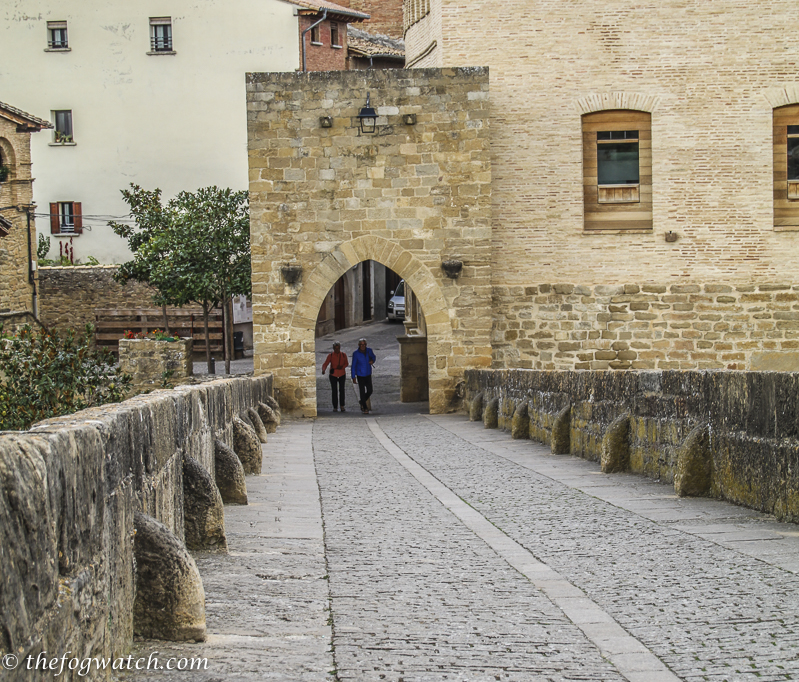
Here at the confluence of the French Way and the Arragonne Way, Pilgrims had also suffered from bands of robbers. When it was built, the bridge had three defensive towers, one of which featured the Renaissance image of the Virgin of Puy, or Txori (meaning ‘bird’ in the Basque language), which is kept in the parish church of St. Peter.
According to the Navarra tourist guide page, there is a story:
“…that a bird used to visit the image every day, removing the cobwebs with its wings and washing the Virgin’s face with its beak after collecting water from the river Arga.”
This is one of the best maintained of the finest medieval bridges in Spain. And it remains in use to this day – though just for pedestrian traffic. One of the remaining defensive towers can be seen at the town end of the bridge.
Roman bridge

Not far out of Puenta la Reina there is a small Roman bridge, still in use today, albeit that it is in poor condition and is approached down a steep and rocky path suitable only for foot traffic.
Burgos
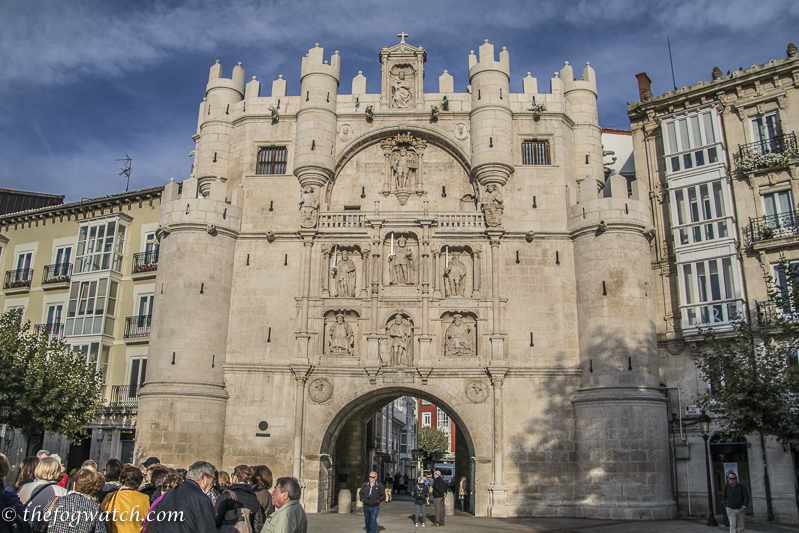
At the entrance to the city of Burgos, lies the Puenta de Santa Maria which dates back to the C14th. You can still see the impressive Arco de Santa Maria or St Mary’s Arch – a defensive structure forming one of the original gates of the city, and part of the original city wall. This city marks the start of Stage VI of the Codex Calixtinus – the medieval codex on which the UNESCO world heritage route of the Camino Frances was based.
Bridge of Arre de Trinidad
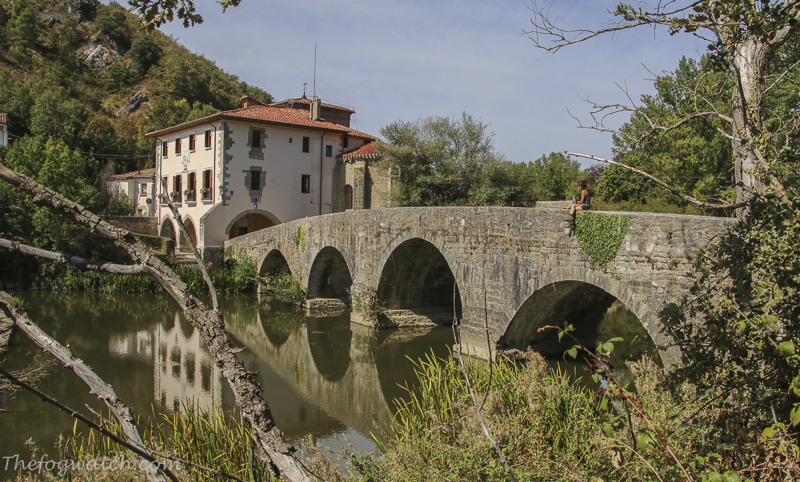
The medieval bridge over the Rio Ulzama (a tributary of the River Arga) leads to possibly the oldest continuously operating albergue – part of the medieval monastery and hospice of the Basilica de la Sanctisima Trinidad de Arre. The hamlet has been a strategic crossing point for the river since Roman times and the place is rich in history.
Puenta de Orbigo
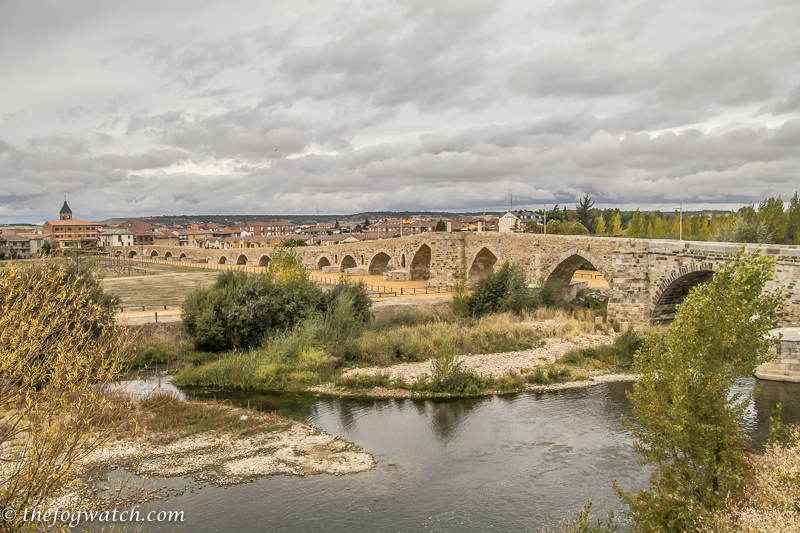
Puenta de Orbigo is one of the longest medieval bridges in Spain, built in the C13th and crossing the floodplain of the Rio Orbigo. The bridge is built on the foundations of an earlier Roman bridge. The town on the far side is called Hospital de Orbigo. – the latter named after the Knights Hospitaller of St John who built a pilgrim’s hospital there. The long causeway leading onto the bridge is known as the Paso Honroso or ‘path of honour’ named for a jousting tournament that took place there in 1434. The story behind it is in the classic Romance chivalry tradition:
“In the Holy Year of 1434 a knight from Leon, Don Suero de Quiñones, scorned by a beautiful woman, threw down the gauntlet to any knight who dared to pass as he undertook to defend the bridge against all comers. Knights came from all over Europe to take up the challenge. Don Suero successfully defended the bridge for a month until the required 300 lances had been broken, and his honour restored. Whereupon he proceeded to Santiago to give thanks for his freedom from the bonds of love.” – Brierley’s Guide
This story may have been part of the inspiration behind Cervantes’ Don Quixote. Nonetheless, this bridge and its Roman predecessor formed part of the cattle route to the coast, facilitating trade and commerce along the route.
Santo Domingo – the Bridge Builder
Santo Domingo de la Calzada, (1020-1109 – Saint Dominic of the Roads – is said to have built one of the first stone bridges across the River Oja around 1044. He was known more as a civil engineer than as the monk to which he aspired, but his efforts in clearing forests and draining swamps as well as constructing bridges and roads on behalf of the pilgrims earned him his place in the pantheon. He, together with his contemporaries, St Gregorio Ostiense and San Juan de Ortega formed one of the first teams of engineers of roads and bridges. The story goes that they met together in Logroño around 1040 and decided to devote themselves to improving the path through La Rioja and Navarra for the pilgrims travelling to Santiago between La Calzada and Logroño.
By clearing the undergrowth there were fewer hiding places for thieves, the road would enable them to cross the swamp more easily, and the bridge across the River Oja completed the work. While there are historical records for the existence of Santo Domingo and San Juan de Ortega, there is little evidence that St Gregorio Ostiense actually existed – he appears to have been a convenient, if somewhat legendary, figure, to make the team a holy trinity.
Whatever the truth, there is little doubt that the efforts to upgrade the infrastructure in the C11th meant a safer passage for the pilgrims at a time when Sancho III was seeking to push the Moors further south and ultimately out of the Kingdom of Spain.
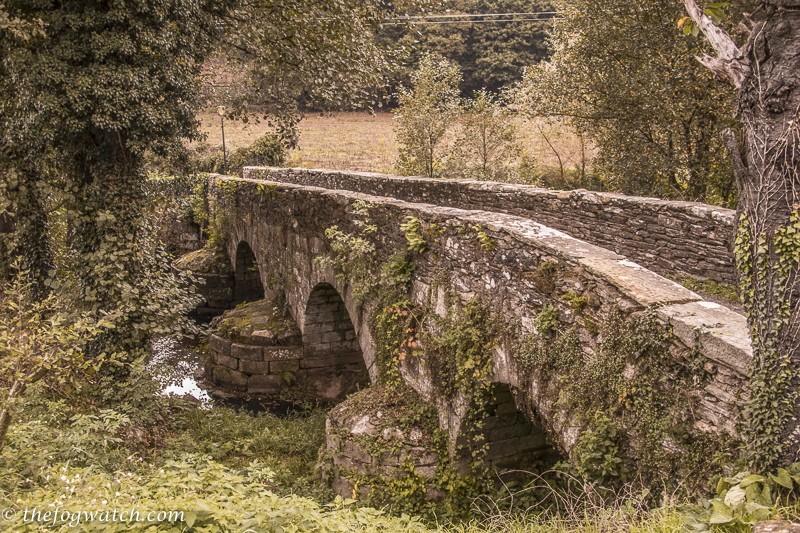
And with safer passage came pilgrims in their thousands, many settling along the road and establishing French towns (known as villafranca). And to service the growing number of pilgrims, larger churches and cathedrals were built – with particularly notable constructions of Burgos and Leon cathedrals – both masterful examples of French Gothic style. And in the process, they brought an exchange of ideas that transcended national boundaries, just as Van Gogh brought a Japanese aesthetic to Europe through a painting of a bridge, and in turn my own pilgrimage to Van Gogh’s places and to Santiago built a bridge between our modern world reaching back into the distant past.
________________________________________
Why not have these posts delivered to your in-box? Just enter your email address and click the ‘subscribe’ button in the left margin, and don’t forget to respond to the confirmation email in your in-box 🙂
________________________________________


Hi Jerry, wonderful and very informative read. Bridges are so much better than walls. While on the Camino, I was very appreciative of the many bridges. Your photos are also very beautiful. Thanks so much for sharing.
Thanks Kathy – yes I’ve always liked bridges and the way the span difficult places – and super respect for the Romans who bridged whole valleys with giant aqueducts!
Thanks for sharing your thoughts on bridges. I so enjoyed them. I wish the broken bridges between cultures could be mended or reconstructed.
Thanks for your thoughtful comment, Margaret – yes, I too wish the broken bridges between cultures could be repaired, making the world a better place for all.
Thoughtful and beautiful, Jerry. Thank you!
Thanks Allie – I have a new appreciation for infrastructure 😀